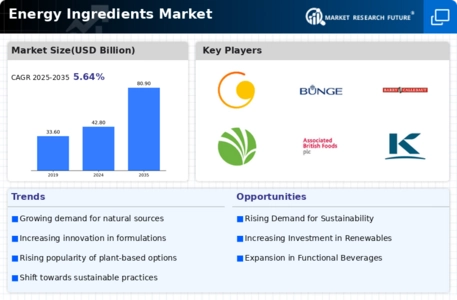Expansion of Sports Nutrition Products
The Energy Ingredients Market is witnessing a significant expansion in the sports nutrition sector, driven by the growing awareness of fitness and health among consumers. This sector includes a variety of products such as protein powders, energy gels, and pre-workout supplements, which are formulated to enhance athletic performance and recovery. Recent statistics indicate that the sports nutrition market is expected to reach a valuation of over 30 billion dollars by 2026, reflecting a robust demand for energy ingredients that support physical activity. As athletes and fitness enthusiasts increasingly seek products that provide sustained energy and improved endurance, manufacturers are focusing on the development of innovative formulations that incorporate natural energy sources. This trend not only enhances the appeal of sports nutrition products but also propels the Energy Ingredients Market forward, as it aligns with consumer desires for effective and reliable energy solutions.
Growth of E-commerce and Online Retailing
The Energy Ingredients Market is experiencing a transformative shift due to the growth of e-commerce and online retailing. As consumers increasingly turn to online platforms for their shopping needs, the accessibility of energy ingredients has improved significantly. This trend is particularly pronounced among younger demographics, who prefer the convenience and variety offered by online retailers. Recent data indicates that e-commerce sales in the food and beverage sector are projected to grow by over 15% annually, highlighting the potential for energy ingredient products to reach a broader audience. Additionally, online platforms provide manufacturers with valuable consumer insights, enabling them to tailor their offerings to meet specific preferences and demands. Consequently, the Energy Ingredients Market is poised to capitalize on this trend, as companies enhance their online presence and marketing strategies to engage with consumers in the digital space.
Increasing Demand for Functional Beverages
The Energy Ingredients Market experiences a notable surge in demand for functional beverages, which are perceived as healthier alternatives to traditional soft drinks. This trend is driven by consumers seeking products that offer not only hydration but also energy-boosting benefits. According to recent data, the functional beverage segment is projected to grow at a compound annual growth rate of approximately 8% over the next five years. This growth is indicative of a broader shift in consumer preferences towards products that enhance physical performance and cognitive function. As a result, manufacturers are increasingly incorporating energy ingredients such as caffeine, taurine, and B vitamins into their formulations to cater to this evolving market. The Energy Ingredients Market is thus positioned to benefit from this trend, as companies innovate to meet the rising consumer expectations for functional and health-oriented beverages.
Rising Health Consciousness Among Consumers
The Energy Ingredients Market is significantly influenced by the rising health consciousness among consumers, who are increasingly prioritizing their well-being and nutritional intake. This shift is evident in the growing preference for energy ingredients that are perceived as natural and beneficial. Consumers are now more inclined to scrutinize product labels, seeking out ingredients that promote energy without adverse health effects. This trend has led to a marked increase in the demand for clean-label products, which are free from artificial additives and preservatives. Market data suggests that the clean-label trend is expected to grow by approximately 10% annually, indicating a strong consumer inclination towards transparency in food and beverage products. Consequently, the Energy Ingredients Market is adapting to these preferences by offering a wider range of energy ingredients that align with health-conscious consumer demands, thereby enhancing market competitiveness.
Technological Innovations in Ingredient Sourcing
The Energy Ingredients Market is benefiting from technological innovations in ingredient sourcing and processing. Advances in extraction and formulation technologies have enabled manufacturers to develop more effective energy ingredients that are both potent and safe for consumption. For instance, the use of biotechnology in the extraction of natural caffeine from coffee beans has improved the efficiency and sustainability of sourcing these ingredients. Furthermore, innovations in encapsulation technology allow for the controlled release of energy ingredients, enhancing their effectiveness in various applications. As a result, the Energy Ingredients Market is likely to see an influx of new products that leverage these technological advancements, catering to the evolving needs of consumers who seek both efficacy and quality in energy-boosting products. This trend not only supports product differentiation but also fosters a competitive edge in a rapidly evolving market.


















Leave a Comment